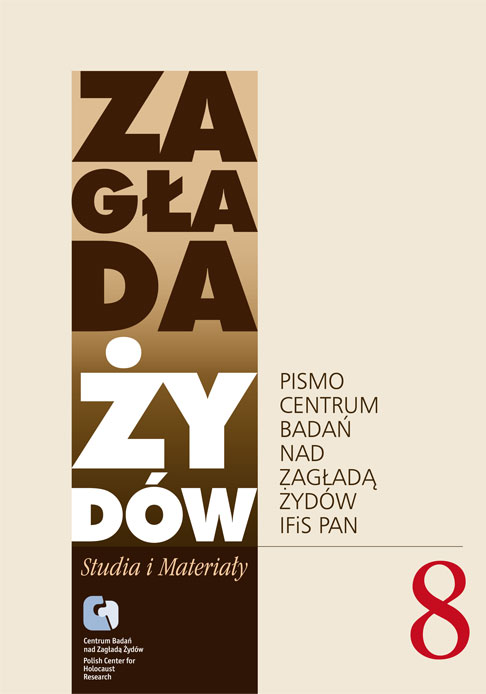Odmienne sylwetki przybyłych do Szwecji więźniów pochodzenia żydowskiego i nieżydowskiego, ocalałych z obozów koncentracyjnych na ziemiach polskich
Zagłada Żydów. Studia i Materiały, Nr 8 (2012), Strony: 419-429
Data zgłoszenia: 2020-12-06Data publikacji: 2012-12-02
 https://doi.org/10.32927/zzsim.698
https://doi.org/10.32927/zzsim.698
Abstrakt
Survivors from Nazi concentration camps, who were brought to Sweden as refugees during the last month of the Second World War and during the summer that followed, were often required to supply information about personal details to the authorities. Much of the information was later stored in written form in the Swedish National Archives. Antisemitism among the refugees and enmity between the Jewish and non-Jewish Polish refugees caused the authorities to include their ethnic or religious affiliation in many records and documents. Using mainly two collections from the Swedish National Archives it is shown that substantial differences existed between Jewish and non-Jewish Polish refugees with respect to their age, education and the length of their war experiences. These differences, in addition to the existing socio-geographic, demographic, cultural and ethnic differences led to inevitable clashes between the two groups. The Swedish authorities who first regarded all refugees of Polish citizenship as one national group had to revise this attitude gradually during the administration of the refugees
Słowa kluczowe
ocalali z Zagłady , Szwecja , stosunki polsko-żydowskie
Licencja
Prawa autorskie (c) 2012 Autor & "Zagłada Żydów. Studia i Materiały"

Utwór dostępny jest na licencji Creative Commons Uznanie autorstwa 4.0 Międzynarodowe.
https://creativecommons.org/licenses/by/4.0
Podobne artykuły
- Jacek Leociak, „Za wyżej wymienione pamiętniki nie żądałem żadnej zapłaty”. Jak Władysław Wójcik ratował dziennik Chaima Arona Kapłana i Archiwum Ringelbluma , Zagłada Żydów. Studia i Materiały: Nr 13 (2017)
- Justyna Kowalska-Leder, Fetyszyzacja autentyczności – casus muzeum-miejsca pamięci , Zagłada Żydów. Studia i Materiały: Nr 17 (2021)
- Jacek Leociak, Ginczanka , Zagłada Żydów. Studia i Materiały: Nr 11 (2015)
- Havi Dreifuss, „Oni wciąż we mnie żyją”. Israel Gutman (1923–2013): ocalały z Zagłady, uczestnik powstania w getcie warszawskim, historyk żydowski , Zagłada Żydów. Studia i Materiały: Nr 10 (2014)
- Kinga Piotrowiak-Junkiert, Imre Kertész in memoriam , Zagłada Żydów. Studia i Materiały: Nr 12 (2016)
- Jan Grabowski, Józef Górski, Na przełomie dziejów , Zagłada Żydów. Studia i Materiały: Nr 2 (2006)
- Redakcja, Od Redakcji , Zagłada Żydów. Studia i Materiały: Nr 8 (2012)
- Andrzej Grzegorczyk, Nowa wystawa stała w Muzeum byłego niemieckiego Obozu Zagłady Kulmhof w Chełmnie nad Nerem , Zagłada Żydów. Studia i Materiały: Nr 16 (2020)
- Jacek Leociak, Literature of the Personal Document as a Source in Holocaust Research (a Methodological Reconnaissance). , Zagłada Żydów. Studia i Materiały: 2008: Holocaust Studies and Materials
- Marta Tomczok, Po co dzisiaj jest Zagłada, czyli poetycki survival , Zagłada Żydów. Studia i Materiały: Nr 17 (2021)
<< < 1 2 3 4 5 6 7 8 9 10 11 12 13 14 15 16 17 18 19 20 21 22 23 24 25 26 27 28 29 30 31 32 33 34 35 36 37 38 39 40 41 42 > >>
Możesz również Rozpocznij zaawansowane wyszukiwanie podobieństw dla tego artykułu.
 English
English
 Język Polski
Język Polski








